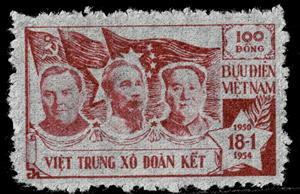Stamp: Georgi Malenkov, Hồ Chí Minh, Mao Zedong (Vietnam 1955)
Georgi Malenkov, Hồ Chí Minh, Mao Zedong (Vietnam 1955)
01 January (Vietnam ) within release Vietnam, China and USSR Friendship Month goes into circulation Stamp Georgi Malenkov, Hồ Chí Minh, Mao Zedong face value 100 Vietnamese đồng
| Stamp Georgi Malenkov, Hồ Chí Minh, Mao Zedong in catalogues | |
|---|---|
| Michel: | Mi: VN 9b |
Stamp is square format.
|
Data entry completed
46%
|
|
|---|---|
| Stamp Georgi Malenkov, Hồ Chí Minh, Mao Zedong in digits | |
| Country: | Vietnam |
| Date: | 1955-01-01 |
| Emission: | Commemorative |
| Format: | Stamp |
| Face Value: | 100 Vietnamese đồng |
Stamp Georgi Malenkov, Hồ Chí Minh, Mao Zedong it reflects the thematic directions:
Communism (from Latin communis, 'common, universal') is a left-wing to far-left sociopolitical, philosophical, and economic ideology within the socialist movement, whose goal is the creation of a communist society, a socioeconomic order centered around common ownership of the means of production, distribution, and exchange that allocates products to everyone in the society based on need. A communist society would entail the absence of private property and social classes, and ultimately moneyand the state (or nation state).
A flag is a piece of fabric (most often rectangular or quadrilateral) with a distinctive design that is used as a symbol, as a signaling device, or as decoration. The term flag is also used to refer to the graphic design employed, and flags have since evolved into a general tool for rudimentary signalling and identification, especially in environments where communication is similarly challenging (such as the maritime environment where semaphore is used). National flags are patriotic symbols with varied wide-ranging interpretations, often including strong military associations due to their original and ongoing military uses. Flags are also used in messaging, advertising, or for other decorative purposes. The study of flags is known as vexillology, from the Latin word vexillum, meaning flag or banner.
A head of state (or chief of state) is the public persona that officially represents the national unity and legitimacy of a sovereign state. In some countries, the head of state is a ceremonial figurehead with limited or no executive power, while in others, the head of state is also the head of government. In countries with parliamentary governments, the head of state is typically a ceremonial figurehead that does not actually guide day-to-day government activities and may not be empowered to exercise any kind of secular political authority (e.g., Queen Elizabeth II as Head of the Commonwealth). In countries where the head of state is also the head of government, the president serves as both a public figurehead and the actual highest ranking political leader who oversees the executive branch (e.g., the President of the United States).



